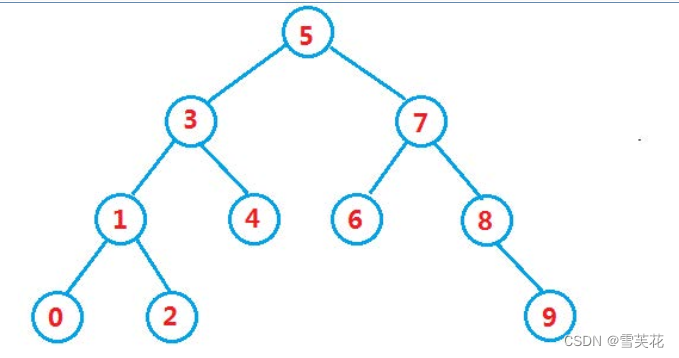C++ 从入门到精通(第十篇) :二叉搜索树
作者:雪芙花
- 2022-10-25 湖南
本文字数:3419 字
阅读完需:约 11 分钟
一:二叉搜索树概念
二叉搜索树又称二叉排序树,它或者是一棵空树,或者是具有以下性质的二叉树:
若它的左子树不为空,则左子树上所有节点的值都小于根节点的值
若它的右子树不为空,则右子树上所有节点的值都大于根节点的值它的左右子树也分别为二叉搜索树
[ ] 例:

int a [] = {5,3,4,1,7,8,2,6,0,9};
二: 二叉搜索树实现
节点的定义
template <class K> //模板class TreeNode{public: TreeNode<K>* _left; TreeNode<K>* _right; K _key; TreeNode(const K & key) :_left(nullptr), _right(nullptr), _key(key) {}};
复制代码
二叉搜索树实现
代码:
#pragma once#include <iostream>using namespace std;
template <class K>class TreeNode{public: TreeNode<K>* _left; TreeNode<K>* _right; K _key; TreeNode(const K & key) :_left(nullptr), _right(nullptr), _key(key) {}};
template <class K>class BSTree{ typedef TreeNode<K> Node;private: Node* _FindR(Node* root, const K& key) { if (root == nullptr) return nullptr;
if (root->_key > key) { return _FindR(_root->_left, key); } else if (root->_key < key) { return _FindR(_root->_right, key); } else { return _root; } } bool _insertR(Node*& root, const K& key) //递归版本,注意传引用 { if (root == nullptr) { root = new Node(key); return true; } if (root->_key > key) { return _FindR(_root->_left, key); } else if (root->_key < key) { return _FindR(_root->_right, key); } else { return false; } } bool _EraseR(Node*& root, const K& key) { if (root == nullptr) { return false; } if (root->_key > key) { return _EraseR(_root->_left, key); } else if (root->_key < key) { return _EraseR(_root->_right, key); } else //找到了 { if (root->_left == nullptr) //假如左子树为空,直接等于右子树 { Node* tem = root; root = root->_right; delete tem; } else if (root->_right == nullptr)//假如右子树为空,root直接等于左子树 { Node* tem = root; root = root->_left; delete tem; } else //左右子树都不为空时,1.先找到右边最小值 2.再保留最小值 3.递归去删除最小值 4.将最小值赋值给root { Node* right = root->_right; while (right->_left) { right = right->_left; } K temkey = right->_key; _EraseR(right,right->_key); root->_key = temkey; } return true; } } void _Destroy(Node* root) //后序销毁 { if (root == nullptr) return; _Destroy(root->_left); _Destroy(root->_right); delete root; } Node* _BSTree(const Node*& root) //深拷贝一个树 { if (root == nullptr) return nullptr; Node* cur = new Node(root->_key); cur->_left = _BSTree(root->_left); cur->_right = _BSTree(root->_right); return cur; }public: BSTree() :_root(nullptr) {} ~BSTree() { _Destroy(_root); } BSTree(const BSTree<K>& a) { _root=_BSTree(a._root); } BSTree<K>& a operator=(const BSTree<K> a) { swap(_root, a._root); return *this; } bool insertR(const K& key) //递归版本 { return _insertR(_root,key); } Node* FindR(const K& key) { return _FindR(_root, key); } bool EraseR(const K& key) { return _EraseR(_root,key); } bool insert(const K& key) //插入一个值 { if (_root == nullptr) //为空时,直接构造一个 { _root = new Node(key); return true; } else //不为空时,利用搜索数的特性找到该插入的位置 { Node* cur = _root; Node* parent = _root; while (cur) { if (cur->_key > key) { parent = cur; cur = cur->_left; } else if (cur->_key < key) { parent = cur; cur = cur->_right; } else { return false; //搜索二叉树不允许有重复的数 } } //循环走完,已经找到了 cur = new Node(key); if (parent->_key > key) { parent->_left = cur; } else { parent->_right = cur; }
return true; } }
Node* Find(const K& key) { Node* cur = _root; while (cur) { if (cur->_key > key) { cur = cur->_left; } else if (cur->_key < key) { cur = cur->_right; } else return cur; } return nullptr; }
bool Erase(const K& key) { Node* parent = nullptr; Node* cur = _root; while (cur) { if (cur->_key > key) { parent = cur; cur = cur->_left; } else if (cur->_key < key) { parent = cur; cur = cur->_right; } else // 找到了 { if (cur->_left == nullptr) { if (cur == _root) _root = cur->_right; else { if (parent->_left == cur) { parent->_left = cur->_right; } else { parent->_right = cur->_right; } } delete cur; } else if (cur->_right == nullptr) { if (cur == _root) { _root = cur->_left; } else { if (parent->_left == cur) { parent->_left = cur->_left; } else { parent->_right = cur->_left; } } delete cur; } else { Node* right = cur->_right; while (right->_left) { right = right->_left; } K temkey = right->_key; Erase(right->_key); cur->_key = temkey; } return true; } } return false; }
void PrintIoder() { Print(_root); cout << endl; } void Print(Node* root) { if (root == nullptr) return;
Print(root->_left); cout << root->_key << " "; Print(root->_right); }private: Node* _root;};
复制代码
三:二叉搜索树的应用
K 模型:
K 模型即只有 key 作为关键码,结构中只需要存储 Key 即可,关键码即为需要搜索到的值。
比如:给一个单词 word,判断该单词是否拼写正确,具体方式如下:
以单词集合中的每个单词作为 key,构建一棵二叉搜索树 在二叉搜索树中检索该单词是否存在,存在则拼写正确,不存在则拼写错误。
KV 模型:
每一个关键码 key,都有与之对应的值 Value,即<Key, Value>的键值对。
比如:
英汉词典就是英文与中文的对应关系,通过英文可以快速找到与其对应的中文,英文单词与其对应的中文<word, chinese>就构成一种键值对;
统计单词次数,统计成功后,给定单词就可快速找到其出现的次数,单词与其出现次数就是<word, count>就构成一种键值对。
四:二叉树有关面试题
ps
想和博主一样刷优质面试和算法题嘛,快来刷题面试神器牛客吧,期待与你在牛客相见
划线
评论
复制
发布于: 刚刚阅读数: 5
版权声明: 本文为 InfoQ 作者【雪芙花】的原创文章。
原文链接:【http://xie.infoq.cn/article/2a3fd533627c666448355b572】。未经作者许可,禁止转载。
雪芙花
关注
还未添加个人签名 2022-04-28 加入
还未添加个人简介










评论